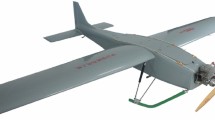Abstract
Many samaras or winged seeds such as maple seeds make an autorotational flight during their falling. Slow descent speed of autorotating maple seeds has been known to be caused by the high lift generated by Leading-edge vortex (LEV) on the seed blade. The autorotation flight of maple seeds is observed to be very stable after detaching from their parent plants, regardless of their initial attitude. In this study, the effects of initial attitude on the flight characteristics of autorotating maple seeds, such as descending velocity, rotational speed and coning angle were investigated experimentally. Depending on the initial attitude, the transitional flight from the initial detachment to the steady-state autorotation is clearly discernible. It starts with downward facing of the seed base, and then approaches equilibrium by changing the pitch and coning angles of the seed. The lower surface faces downward and tumbles to the downward facing state of the leading edge. Among the six initial attitudes tested, the downward facing of the seed’s lower surface exhibits the fastest stabilization. Most maple seeds belong to the case of downward facing of lower surface. The present results demonstrate that the maple seeds make a stable autorotation within a distance of 660 mm after detaching from their parent plants, regardless of their initial attitude.
Similar content being viewed by others
References
H. F. Howe and J. Smallwood, Ecology of seed dispersal, Annual Review of Ecology and Systematics (1982) 201–228.
M. Willson, Dispersal mode, seed shadows and colonization patterns, Vegetatio, 107 (1993) 261–280.
D. Greene and E. Johnson, Seed mass and dispersal capacity in wind-dispersed diaspores, Oikos (1993) 69–74.
S. Minami and A. Azuma, Various flying modes of winddispersal seeds, J. of Theoretical Biology, 225 (2003) 1–14.
C. K. Augspurger, Morphology and dispersal potential of wind-dispersed diaspores of neotropical trees, American J. of Botany (1986) 353–363.
E. R. Ulrich, D. J. Pines and J. S. Humbert, From falling to flying: the path to powered flight of a robotic samara nano air vehicle, Bioinspiration & Biomimetics, 5 (2010) 045009.
J. G. Leishman, Principles of helicopter aerodynamics with CD extra, Cambridge U.P. (2006).
C. McCutchen, The spinning rotation of ash and tulip tree samaras, Science, 197 (1977) 691–692.
K. Yasuda and A. Azuma, The autorotation boundary in the flight of samaras, J. of Theoretical Biology, 185 (1997) 313–320.
A. Azuma and K. Yasuda, Flight performance of rotary seeds, J. of Theoretical Biology, 138 (1989) 23–53.
A. Rosen and D. Seter, Vertical autorotation of a singlewinged samara, J. of Applied Mechanics, 58 (1991) 1064–1071.
J. M. Birch, W. B. Dickson and M. H. Dickinson, Force production and flow structure of the leading edge vortex on flapping wings at high and low Reynolds numbers, J. of Experimental Biology, 207 (2004) 1063–1072.
F. Muijres, L. Johansson, R. Barfield, M. Wolf, G. Spedding and A. Hedenström, Leading-edge vortex improves lift in slow-flying bats, Science, 319 (2008) 1250–1253.
C. P. Ellington, C. van den Berg, A. P. Willmott and A. L. R. Thomas, Leading-edge vortices in insect flight, Nature, 384 (1996) 626–630.
D. Lentink, W. B. Dickson, J. L. van Leeuwen and M. H. Dickinson, Leading-edge vortices elevate lift of autorotating plant seeds, Science, 324 (2009) 1438–1440.
E. Salcedo, C. Treviño, R. O. Vargas and L. Martínez-Suástegui, Stereoscopic particle image velocimetry measurements of the three-dimensional flow field of a descending autorotating mahogany seed (Swietenia macrophylla), Journal of Experimental Biology, 216 (2013) 2017–2030.
S. J. Lee, E. J. Lee and M. H. Sohn, Mechanism of autorotation flight of maple samaras (Acer palmatum), Experiments in Fluids, 55 (2014) 1–9.
R. Norberg, Autorotation, self-stability, and structure of single-winged fruits and seeds (samaras) with comparative remarks on animal flight, Biological Reviews, 48 (1973) 561–596.
K. Varshney, S. Chang and Z. J. Wang, The kinematics of falling maple seeds and the initial transition to a helical motion, Nonlinearity, 25 (2012) C1.
Author information
Authors and Affiliations
Corresponding author
Additional information
Recommended by Associate Editor Dongshin Shin
Sang-Joon Lee is a professor in Mechanical Engineering at POSTECH and director of the Biofluid and Biomimic Research Center. His research interests are in bio-fluid flows, microfluidics, quantitative flow visualization and experimental fluid mechanics.
Eui-Jae Lee received his M.S. in Mechanical Engineering from POSTECH and is now a Ph.D. student. His research interests are in flow visualization, applications of PIV velocity field techniques and wind tunnel experiments.
Rights and permissions
About this article
Cite this article
Lee, EJ., Lee, SJ. Effect of initial attitude on autorotation flight of maple samaras (Acer palmatum). J Mech Sci Technol 30, 741–747 (2016). https://doi.org/10.1007/s12206-016-0129-2
Received:
Revised:
Accepted:
Published:
Issue Date:
DOI: https://doi.org/10.1007/s12206-016-0129-2




